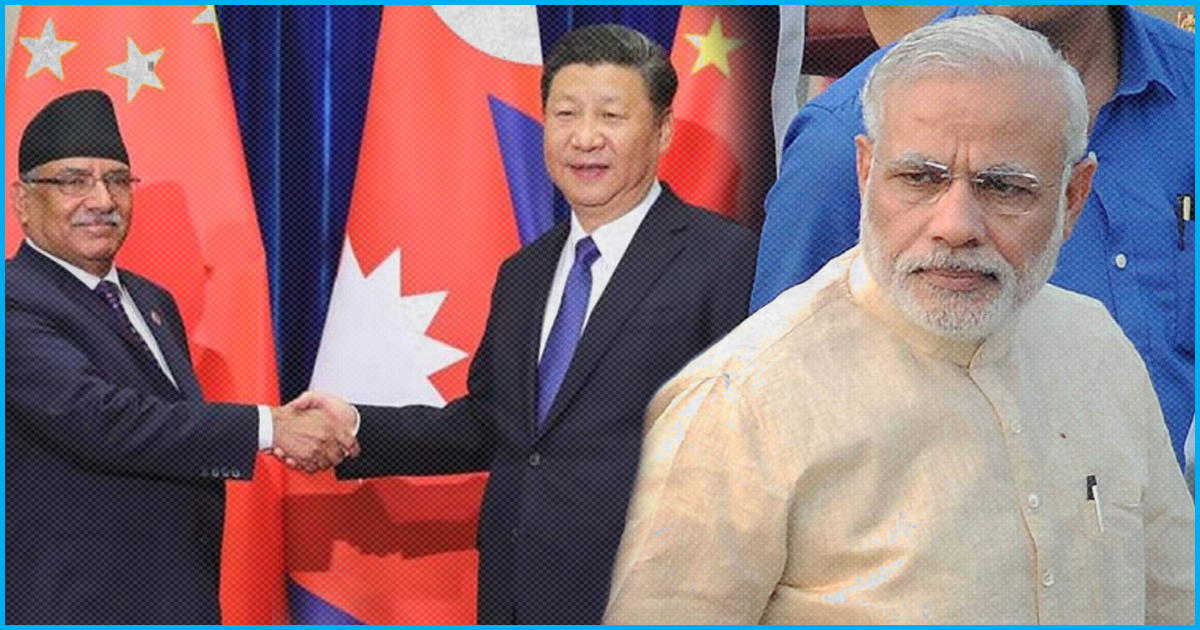
TLI Explains: Nepal Says No To India For Military Exercise, To Participate With China Instead
11 Sep 2018 10:45 AM GMT
On Saturday, September 8, Nepal pulled out of the BIMSTEC military exercise in Pune at the last minute, even when an advance military team from Nepal had reportedly already arrived in India. This comes at a time when Nepal has agreed to participate in a 12-day long military exercise, Sagarmatha Friendship-2, with China from September 17-28 in Chengdu, as reported by The Times Of India. Earlier last week, Kathmandu and Beijing finalised a trade protocol that granted Nepal access to China’s ports. This will reduce Nepal’s dependence on India and allow China to get a firmer foothold in the subcontinental drama.
During the BIMSTEC summit held at Kathmandu last month, PM Modi hailed the “multi-national military field training exercise.” However, Nepal’s decision to pull out mere days after the summit is bound to be seen as suspicious by India. To add to this, Nepal seems to have made the success of BIMSTEC conditional to the revival of SAARC.
BIMSTEC, SAARC & Pakistan
Both, BIMSTEC and SAARC are regional groupings of Asian nations with India at the centre and China not a part of either, as of now. The stark difference between BIMSTEC and SAARC is that Pakistan is a part of SAARC but not a part of BIMSTEC.
What is BIMSTEC?
BIMSTEC or the Bay of Bengal Initiative for Multi-Sectoral Technical and Economic Cooperation was founded in 1997 and comprises Bangladesh, Bhutan, India, Nepal, Sri Lanka, Thailand and Myanmar.
Just last month, the fourth BIMSTEC summit was held at Kathmandu, Nepal. As reported by The Economic Times, in June, the Indian army proposed holding a joint military drill. BIMSTEC has been mostly dormant with only four summits since its inception in 1997. Moreover, there is not even a guiding charter in place even after two decades. However, after the third summit in 2014, India’s renewed interest and vigour is seen by many as a move to sideline SAARC. Several people have pointed out that BIMSTEC was never meant to be a platform for holding joint military exercises. The joint military exercise at Pune began on Monday, September 10, and Nepal’s decision on Saturday/Sunday meant that only an observer team from the landlocked nation is participating.
What is SAARC?
SAARC or the South Asian Association for Regional Cooperation was founded in 1985 and comprises India, Pakistan, Afghanistan, Bhutan, Bangladesh, Maldives, Nepal and Sri Lanka. There has been little in terms of regional cooperation as India and Pakistan are almost always at loggerheads and SAARC’s consensus-based decision-making process gets derailed.
In 2016, India took a strong stand and refused to attend the 19th SAARC summit in Pakistan in the wake of the Pathankot and Uri attacks. Subsequently, the other SAARC nations also boycotted the summit. India’s stance that talks and terrorism can’t go together means that India is set to boycott the upcoming summit in Islamabad again.
China in SAARC?
During the time of the 2014 SAARC summit in Kathmandu, Pakistan and Nepal agreed to make China a full SAARC member, as reported by The Diplomat. As Pakistan is set to host the summit again this year, it is reportedly seeking support from other South Asian nations. Nepal is the current chair of SAARC and under a communist-led regime. With Nepal expressing the intent to “revive” SAARC, it is not that far-fetched to think that a proposal to induct China in SAARC is on the cards.
India, Nepal & China
Historical ties and geographical proximity have made India and Nepal natural allies. However, during 2015-16, the Madheshi issue, the economic blockade, and the Nepalese constitution caused a strain in the Indo Nepalese relationship. Also, the current Nepalese Prime Minister KP Oli who leads the now-unified Communist Party of Nepal is perceived to be pro-China.
Recently, Pushpa Kamal Dahal ‘Prachanda’, the former PM of Nepal and chairperson of the Communist Party of Nepal, was in Delhi and met India’s political leadership including PM Modi. Reportedly, Prachanda claimed that it was the erstwhile monarchy which played India and China against each other while the current government wants to improve relations with both India and China. Prachanda’s co-chair, PM Oli has also backed the idea of Nepal-India-China trilateral cooperation.
Even though Nepal remains optimistic, the idea of India and China cooperating for the benefit of a third country seems unrealistic. Also, Nepal can’t afford to antagonise India too much as China’s aid and investment often come with undesired and intrusive add-ons. What the landlocked nation needs, is to boost its economy and trade.
The recent transit protocol will allow Nepal to use Chinese ports. However, the nearest Chinese port is more than 2,600 km away from the border of Nepal. Reportedly, as connectivity and infrastructure remain an issue, China has proposed to build a railway link into Nepal and an electric transmission line.
It is to be noted that Nepal’s tilt towards China is not without restraint. It was just last year that Nepal and China jointly participated in a military exercise for the first time and this year’s military exercise will be on a similar scale. Reportedly, not more than 20 soldiers from Nepal will participate in the Chengdu exercise. The point which many feel Nepal is trying to make is that in BIMSTEC it feels overshadowed by India while in SAARC it sees itself as an ‘equal’ due to the consensus-based decision-making system. Moreover, Nepal and China, although both led by communist regimes, have very little in common be it in terms of the nature of government, people to people contact or their stance towards India.
India, on its part, has been trying to improve relations with both Nepal and China. After the Doklam standoff, PM Modi has visited China twice just in 2018, once for an ‘informal meeting’ with Xi Jinping and then for the Shanghai Cooperation Summit. PM Modi has also visited Nepal multiple times and it is significant as, before him, visits to Nepal by Indian Prime Ministers were few and far between. Reportedly, India has proposed to help Nepal construct a railway line between Kathmandu and the Indian border town of Raxaul, from where the bulk of Nepal’s overland foreign trade is routed through as of now. Also, India has reportedly softened its stance on several issues which were previously considered as non-negotiable.
India does not want Chinese interference in Kashmir and the idea of China joining SAARC is not at all palatable. Nepal is trying to carve a space for itself, stuck between the world’s two most populous nations. It remains to be seen what the newly elected Pakistan PM brings to the table, although many suspect that it would be the case of old wine in a new bottle. As always, the Asian diplomatic minefield is further complicated by the USA and if it perceives strengthening of Pak-China ties then its displeasure can manifest in the form of support to India.
Also read: A Brief Timeline On Nepal’s Political History With An Analysis Of Its Constitution
 All section
All section













